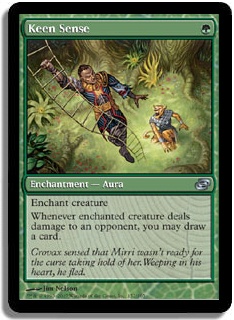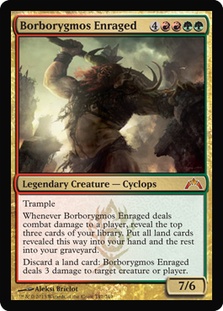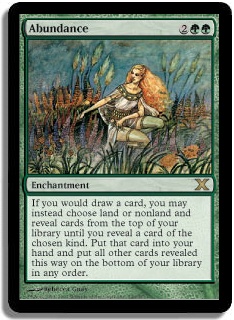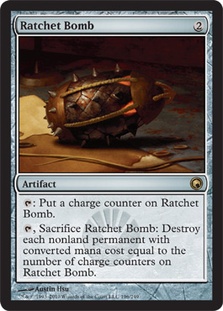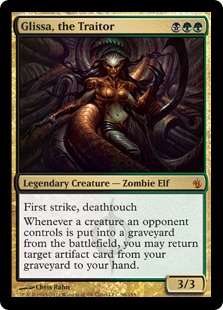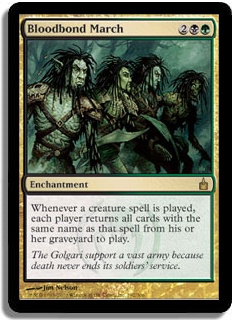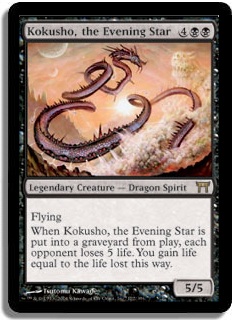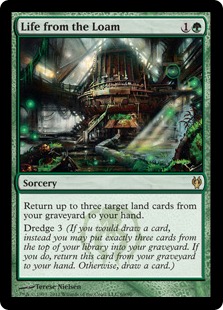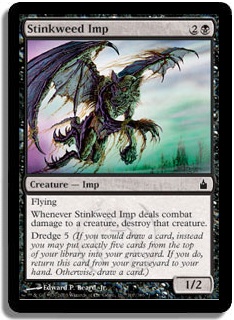First off, I wanted to say thanks for all of you who gave their two cents on the Borborygmos Enraged Commander decks I wrote about last week—I got a ton of comments and feedback, and I really appreciate the enthusiasm for our new Gruul overlord! A special shout-out to those who mentioned giving BB&G Curiosity with the green counterparts: Keen Sense and Snake Umbra. This brings him up to almost Niv-Mizzet-like power, something that’s nice to see in green/red. If you have Abundance in play, you can pretty much throw a never-ending stream of lands at your opponents, though you’ll probably want some way to restock your library despite the fact that the draw from both of those Auras is a “may.”
This week’s column was inspired by a couple comments regarding my column two weeks ago presenting some new Gatecrash Standard brews I tossed out for readers to chew on and give me feedback on:
“How do any of these decks survive Bant or even control for that matter?”
“To be honest, all of these decks are completely unplayable fundecks. You must realize that there are 100x times better decks already in Standard?”
Whenever you write something that’s put out there for public consumption, you have to be prepared for these sorts of things—it’s the cost of doing business when you’re a writer. Even so, the negativism stings. Now, it would certainly be easy to just write off these comments and move on…but the comments made me wonder two things:
Why do I write about Standard? And why do people read what I write about Standard?
I have to admit, sometimes the Standard format frustrates me. With the advent of the mythic rarity and the fact that I don’t have an unlimited Magic budget, no longer am I able to realistically have all the playable cards in the format to build decks around; I have to carefully pick and choose the singles that I want to buy, especially the mythic rares. When picking these cards, I think about how much fun I will have with these cards—not only in Standard, but in Modern, maybe Legacy, and certainly Commander—weighed against how good/powerful I expect them to be. I do get a lot of joy playing fun cards, but I got a lot more joy winning with fun cards. Sometimes the Standard metagame presents a pretty hostile environment for the cards and strategies that I’ve invested my time and money in, and that can be a bummer…but the sweet thing is, four times a year a brand new set hits that has the potential to shake everything up.
This is the time of year when the sky’s the limit—there’s opportunity for new ideas to be born, old ideas that didn’t quite work to get a boost, and old strategies that have been oppressing me to maybe get a kick in the teeth. This is part of the reason why I brew… the sheer joy of discovery! New brews are like fresh-faced children all full of life and potential… but then, all too soon, like children growing up and getting tossed into the real world, they get battered and beaten by the harsh light of reality. Sometimes you’ve got to accept that that path you’ve chosen isn’t ideal or, worse, is just plain terrible.
The comments above seem to suggest—why bother? Why waste time on these brews when you can just wait to see what the pros and semi-pros brew up and fine-tune and just nab a good deck and grind with it?
Because sometimes… sometimes brews find the right time and place to be awesome! If you’ve read me the past 18 months or so, you know for a while there I worked hard on a G/B Glissa Birthing Pod deck. It started out as a brew and was certainly dismissed by casual observers as a “completely unplayable fundeck.” However, even in its original form I found it to be competitive and powerful but with not quite the juice needed to jump up to Tier 1.
That changed with Dark Ascension and the undying mechanic. Suddenly I had a way to juice up my deck… and it also turned out that the metagame shifted to where recurring Ratchet Bombs with Glissa were really good. I decided to play the deck at the StarCityGames.com Open right here in Richmond exactly one year ago, despite the fact that I wouldn’t be able to play the whole tournament because of the Girl Scout Father/Daughter dance I had to go to that night. I figured if I were wrong, no biggie, I could drop and go to the dance, no sweat off my brow.
If I were right… well, it would suck to have to drop while on a winning streak… but then I’d have been right!
Turns out, I was right. I went 5-2 before having to drop, with the two losses coming off mistakes I made that my opponent was able to capitalize on. By the time I dropped I was on a roll, really getting into the rhythm of playing the deck and confident I could have easily won the next two matches and made somewhere between Top 10 and Top 20 out of 300 people.
Another example… back in 2005, in the week or so leading up to States, my friend Jay Delazier and I were trying to brew up a deck featuring Bloodbond March, an enchantment from the just-released Ravnica expansion. The end-goal of the deck was to play Kokusho, the Evening Star with one or more copies already in the graveyard, which would jump into play and then immediately die, generating a 10, 15, maybe even 20 point life drain on our opponent, potentially ending the game right on the spot due to the legend triggers. The best way we could figure to set up the end goal was to run four copies of Kokusho and utilize the new dredge mechanic to fill the graveyard with extra copies (assuming we drew one copy).
Now at the time dredge was pretty much dismissed as a Limited-worthy mechanic at best but one that was dangerous because you could end up decking yourself. The Bloodbond March deck would certainly have been easily dismissed by the casual observer as a “completely unplayable fundeck.”
Yet a funny thing happened as we tested the deck… we kept beating people playing the Tier 1 decks on the back of the dredge mechanic alone. We hardly ever actually got Bloodbond March in play—it always seemed to get milled into the graveyard with dredge—but we kept beating people with Darkblast, Life from the Loam, Stinkweed Imp, Moldervine Cloak, and Greater Mossdog! Eventually we ditched Bloodbond March altogether and just made a dedicated Dredge deck with just a day left to test for States, and I did my best to tune it to what we expected at States. Much to everyone’s surprise, it kept winning! I decided no way was I not going to run this thing at States, and I ended up marching right on into the Top 8 with it, missing out on the Top 4 due to a dumb mistake.
The thing to remember is that this was before Dredge got “broken” with cards like Narcomoeba, Bridge from Below, and Dread Return (none of which had been printed yet). The Dredge we know now is a fast combo deck; the Dredge deck that was available to build back then was slow, grindy, and just plain weird, playing in a way that had never been done in Magic before. Nobody had given it a chance because, on paper, it just looked bad.
Over on the Mothership, even Michael Flores had to take notice when doing his recap of top decks from States that year:
“Check out Virginia’s number five… That’s our own Bennie Smith behind… one of the ugliest decks I’ve ever seen….
“Now it is said that nobody remembers second place, and certainly fifth place is not usually something to write home about, but Bennie’s deck is genuinely… odd. Running a Stinkweed Imp engine to hold off even the most efficient, sleek, and beautiful threats on a persistent basis, Bennie can Dredge through his deck to set up a Demonic Tutor-like availability of graveyard options.”
I took great honor in breaking onto Flores’s Top Decks radar as one of the Ugliest Decks Ever Seen, hee hee!
Here’s the other thing about brews that makes me love them so much… sometimes they end up being a lot better than anyone gives them credit for being, especially if you can test it and tweak it. Modern Magic has gotten to the point that everyone knows the best decks, and the best players grind matches to the point where, for any given match, they know what lines of play they need to pursue and what sort of endgame they need to work towards. Even if you don’t have time to grind, you can watch videos of Magic players who do right here on StarCityGames.com and scoop up the knowledge you need.
When you’ve got a brew that’s not on anyone’s radar and that looks bad on paper but is actually something you’ve tuned and made into a good deck, you get a real edge against these grinders who would normally annihilate people playing the best netdecks. With those, after your first play, they already know what they need to do to beat you and what you could possibly do to beat them. When you play a good brew, you’re coming at them from the darkness. Sure, the best players will generally be able to figure out what you’re up to, but it’s still new ground they haven’t seen before. There’s more room for play errors, which gives you more room to win. For someone like myself who has kids and two jobs and very little time to grind games, that edge can make a world of difference.
I was hoping to have some of that edge when I gave Necrotic Ooze a whirl in Modern. In testing the deck online, I struggled against Storm combo and Jund, which certainly made me question the viability of the deck. Well, well… now that Bloodbraid Elf and Seething Song have been banned, perhaps I’ll give it another try!
Before I wrap things up, I couldn’t write a column about the value of brewing up fun decks without mentioning my latest mancrush Travis Woo. I’d heard of Travis due to the popularity of his wacky Omnidoor decks, and while that style of deck wasn’t really my cup of tea, I appreciated his rogue sensibilities from afar.
Then I ran across this picture someone posted on Facebook, said it came from one of Travis Woo games he was streaming on Twitch TV:
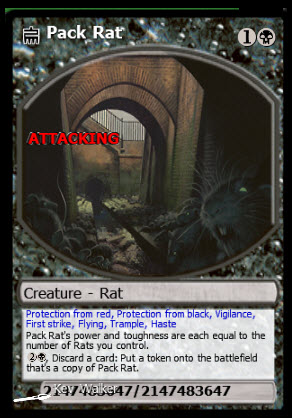
Alright, the abilities in blue obviously came from Akroma’s Memorial(!), but what I was dying to know was—how did he get a Pack Rat that big?!? 2,147,483,647 power and toughness! Did he have that many Pack Rat tokens?
I searched up the streaming game on Twitch TV and found out he was playing a wacky Primal Surge deck, and that Rat was accomplished with some sort of combination of Wild Beastmaster, Craterhoof Behemoth, and Infinite Reflection.
Another game, he made a crapload of Thragtusks with the deck and posted this on his Facebook page:
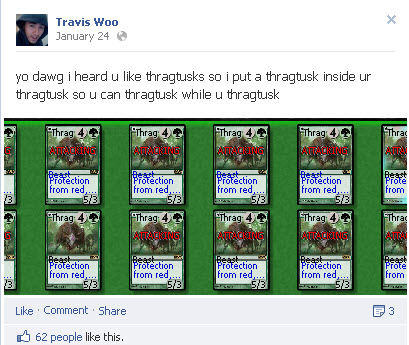
It just cracked me up listening to him talk and watching him play. This is a guy who loves playing wacky homebrews… but he really loves winning with those wacky homebrews. He wants to do fun, crazy things in Magic, surprise his opponents… and beat them! There’s an edge to be had in playing something that your opponent is at least partially unfamiliar with. Even if you know Travis Woo and can expect him to play four copies of Gilded Lotus and some number of Diabolic Revelations, can you really guess what’s going to be in the rest of the deck this time around?
I was talking with a friend at Richmond Comix last weekend about Travis Woo and how very glad we were that he was out there doing these things and sharing them with the world. Magic’s a better place the more players there are who tap into the joy of creation when building their Magic decks. I try and do that here in my column, not only just to share my lists in the hopes that my readers might offer constructive criticism, but also to inspire the joy of creation in others. Not just because playing these sorts of decks can be so much fun… but because sometimes these decks can actually win!
What do you think? Got any Gatecrash Standard homebrews that are outside the box but happen to be doing well for you? Let me know in the comments below!
Take care,
Bennie
starcitygeezer AT gmail DOT com
Make sure to follow my Twitter feed (@blairwitchgreen). I check it often so feel free to send me feedback, ideas, and random thoughts. I’ve also created a Facebook page where I’ll be posting up deck ideas and will happily discuss Magic, life, or anything else you want to talk about!
I write a blog that you may find it fun to read and comment on. I update at least once a week so check on it often and let me know what you think!
New to Commander?
If you’re just curious about the format, building your first deck, or trying to take your Commander deck up a notch, here are some handy links:
- Commander Primer Part 1 (Why play Commander? Rules Overview, Picking your Commander)
- Commander Primer Part 2 (Mana Requirements, Randomness, Card Advantage)
- Commander Primer Part 3 (Power vs. Synergy, Griefing, Staples, Building a Doran Deck)
- Commander Starter Kits 1 (kick start your allied two-color decks for $25)
- Commander Starter Kits 2 (kick start your enemy two-color decks for $25)
- Commander Starter Kits 3 (kick start your shard three-color decks for $25)
My current Commander decks (and links to decklists):
- Borborygmos Enraged (69 land deck)
- Aurelia, the Warleader (plus Hellkite Tyrant shenanigans)
- Oona, Queen of the Fae (by reader request)
- Karador, Ghost Chieftain (my Magic Online deck)
- Karona, False God (Vows of the False God)
- Skullbriar, the Walking Grave (how big can it get?)
- Phage the Untouchable (actually casting Phage from Command Zone!)
- Johan (Cat Breath of the Infinite)
- Niv-Mizzet, the Firemind (Chuck’s somewhat vicious deck)
Previous Commander decks currently on hiatus:
- Yeva, Nature’s Herald (living at instant speed)
- Nefarox, Overlord of Grixis (evil and Spike-ish)
- Niv-Mizzet, Dracogenius (new player-friendly)
- Trostani, Selesnya’s Voice (new player-friendly)
- Jarad, Golgari Lich Lord (drain you big time)
- Riku of Two Reflections (steal all permanents with Deadeye Navigator + Zealous Conscripts)
- Phelddagrif (Mean Hippo)
- Sigarda, Host of Herons (Equipment-centric Voltron)
- Bruna, Light of Alabaster (Aura-centric Voltron)
- Ruhan of the Fomori (lots of equipment and infinite attack steps)
- Ghave, Guru of Spores (Melira Combo)
- Glissa, the Traitor (undying artifacts!)
- Grimgrin, Corpse-Born (Necrotic Ooze Combo)
- Damia, Sage of Stone (Ice Cauldron shenanigans)
- Geist of Saint Traft (Voltron-ish)
- Glissa Sunseeker (death to artifacts!)
- Jor Kadeen, the Prevailer (replacing Brion Stoutarm in Mo’ Myrs)
- Thelon of Havenwood (Campfire Spores)
- Melira, Sylvok Outcast (combo killa)
- Konda, Lord of Eiganjo (The Indestructibles)
- Vorosh, the Hunter (proliferaTION)
- Progenitus (Fist of Suns and Bringers)
- Savra, Queen of the Golgari (Demons)
- Uril, the Miststalker (my “more competitive” deck)

